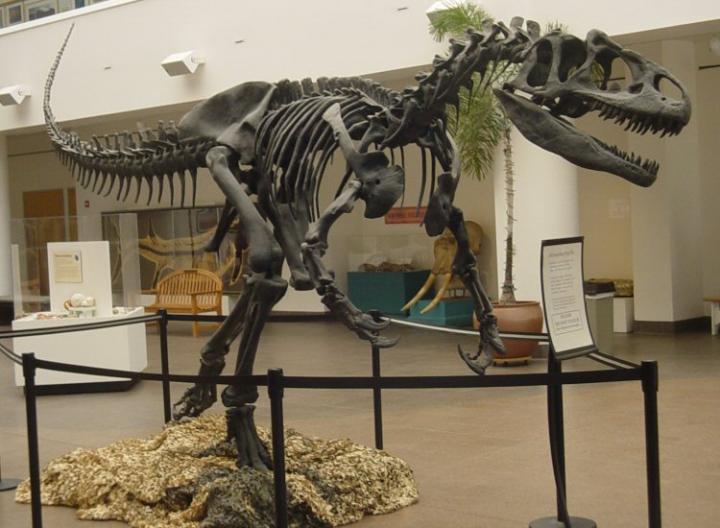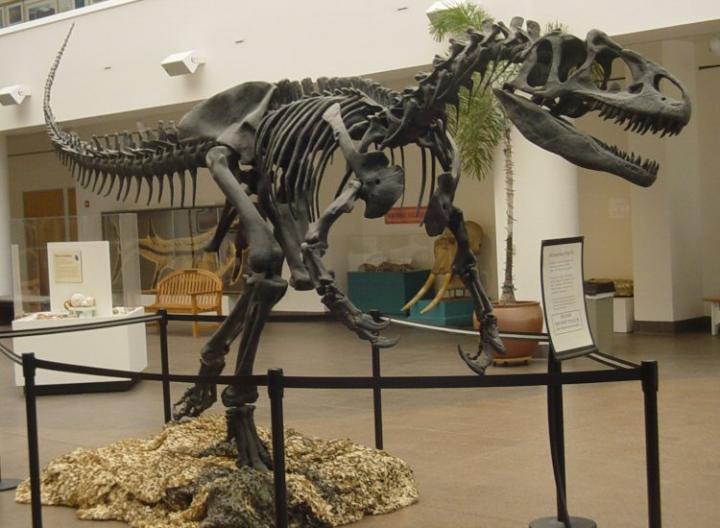
Credit: Wikipedia
The Cleveland-Lloyd Dinosaur Quarry is the densest collection of Jurassic dinosaur fossils. Unlike typical Jurassic bone beds, it is dominated by the famous predatory dinosaur Allosaurus.
Since its discovery in the 1920s, numerous hypotheses have been proposed to explain the origin of the quarry. Were the dinosaurs poisoned? Did they die due to drought? Were they trapped in thick mud?
A new study published in the peer-reviewed journal PeerJ introduces modern techniques to better understand the landmark site's history, suggesting that the quarry represents numerous mortality events which brought the dinosaurs to the site over time, rather than a single fatal event.
This study reveals that the small bone fragments were created during drought periods by weathering and erosion of bones disintegrating at the surface. During flood periods, however, the carcasses of Allosaurus and other dinosaurs washed in and rotted in a small pond, creating an environment in which fish, turtles, and crocodiles could not survive, and other dinosaurs would not eat the carcasses.
The data generated from new and innovative methods, including chemical analyses and the study of microscopic bone fragments, suggest that dinosaur bones were introduced to the deposit after death. This would also explain the unusual lack of typical pond fossils at the site, as well as the near lack of gnaw marks on bones and calcite and barite concretions found on bones excavated from the quarry.
The new hypothesis helps paleontologists understand the setting of the quarry, and to begin to unravel the mystery that led to this unique, Allosaurus-dominated bone bed.
###
Full Media Pack including images: https://drive.google.com/open?id=0BzGrFBtalE6wNGRqSi1QamVKRUE
PDF of this Press Release: http://static.peerj.com/pressReleases/2017/06/Press-Release-Peterson.pdf
Link to the Published Version of the article (quote this link in your story – the link will ONLY work after the embargo lifts): https://peerj.com/articles/3368/ your readers will be able to freely access this article at this URL.
Citation to the article: Peterson et al. (2017), New data towards the development of a comprehensive taphonomic framework for the Late Jurassic Cleveland-Lloyd Dinosaur Quarry, Central Utah. PeerJ 5:e3368; DOI 10.7717/peerj.3368
About:
PeerJ is an Open Access publisher of two peer-reviewed journals and a preprint server. PeerJ is based in San Diego, CA and the UK and can be accessed at https://peerj.com/. PeerJ 's mission is to help the world efficiently publish its knowledge.
All works published in PeerJ are Open Access and published using a Creative Commons license (CC-BY 4.0). Everything is immediately available–to read, download, redistribute, include in databases and otherwise use–without cost to anyone, anywhere, subject only to the condition that the original authors and source are properly attributed.
PeerJ has an Editorial Board of over 1,600 respected academics, including 5 Nobel Laureates. PeerJ was the recipient of the 2013 ALPSP Award for Publishing Innovation. PeerJ Media Resources (including logos) can be found at: https://peerj.com/about/press/
Media Contacts
For the authors:
Dr. Joseph Peterson
University of Wisconsin Oshkosh
Department of Geology
(920) 424-4463
[email protected]
For PeerJ : email: [email protected] , https://peerj.com/about/press/
Note: If you would like to join the PeerJ Press Release list, please register at: http://bit.ly/PressList
Media Contact
Joseph Peterson
[email protected]
920-424-4463
@ThePeerJ
http://https://peerj.com
Original Source
http://static.peerj.com/pressReleases/2017/06/Press-Release-Peterson.pdf http://dx.doi.org/10.7717/peerj.336
############
Story Source: Materials provided by Scienmag





